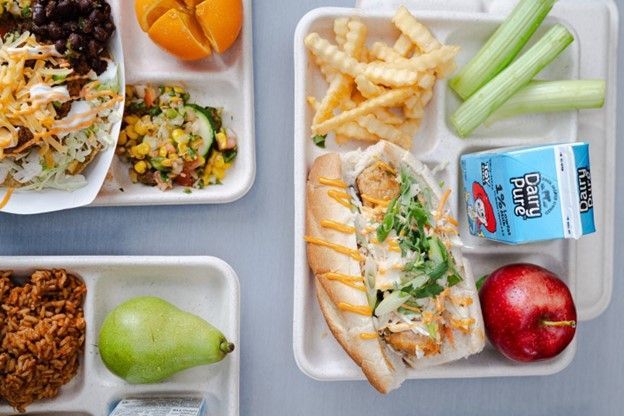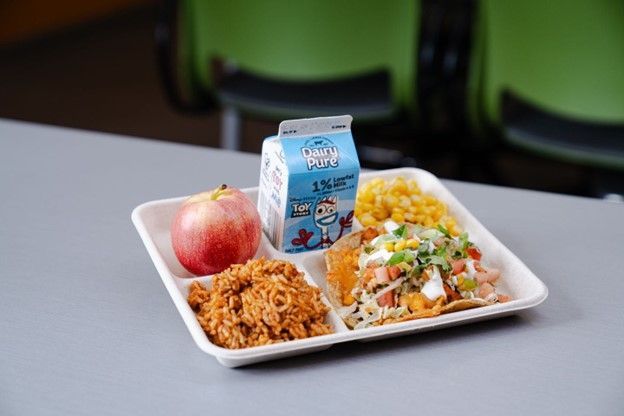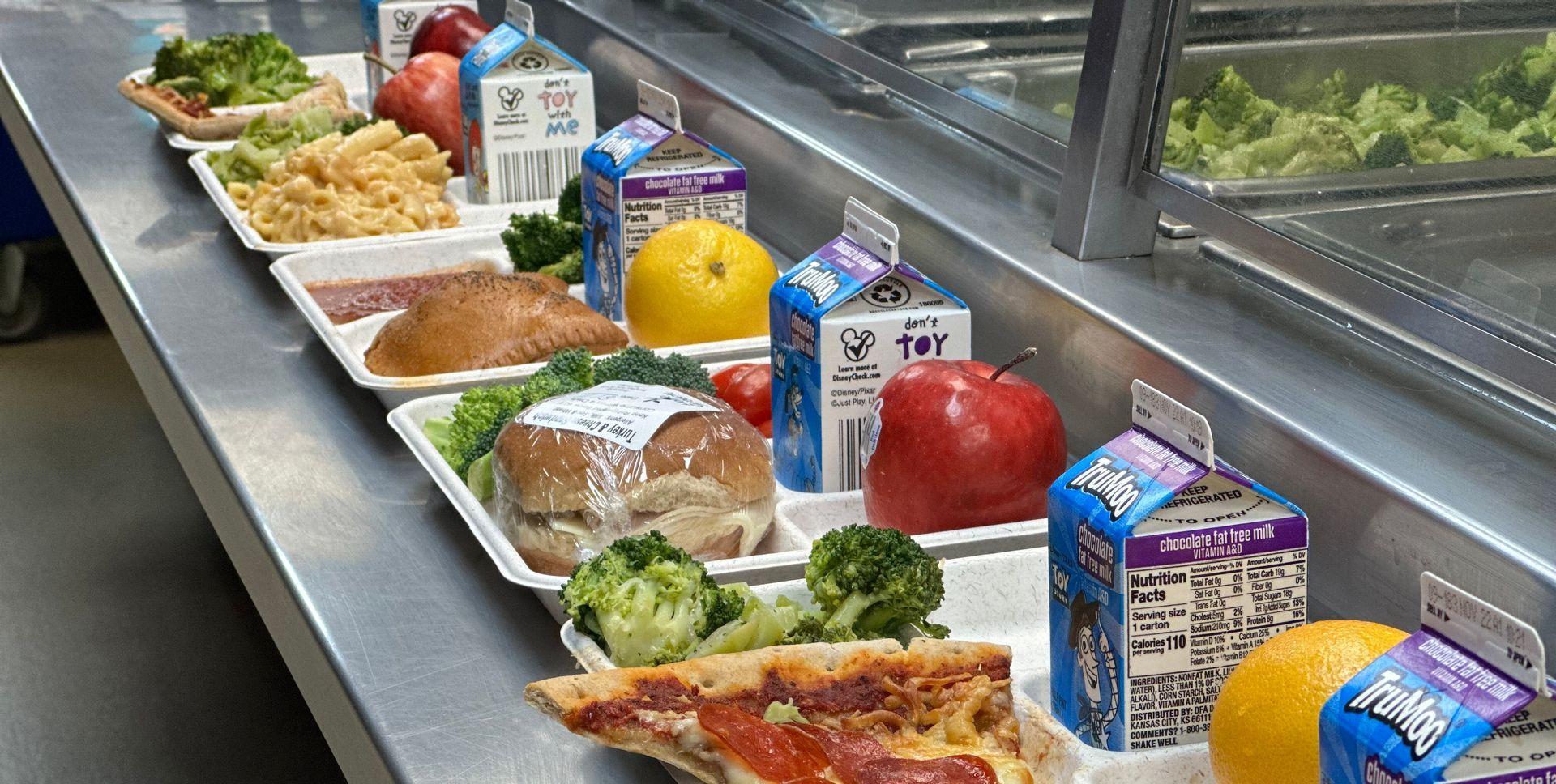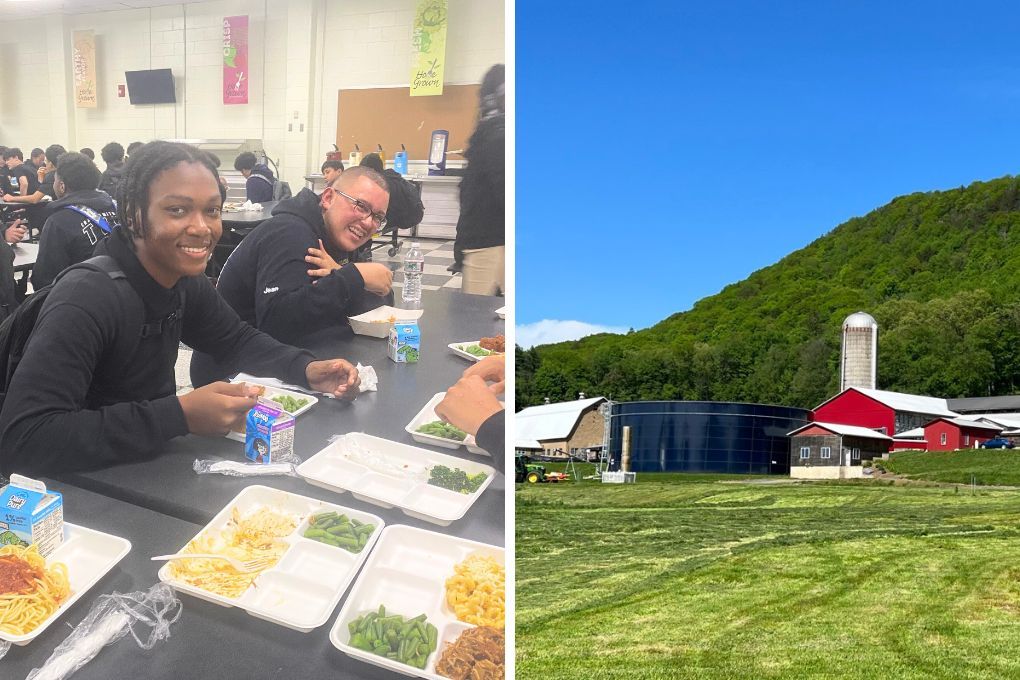A quiet revolution has been taking place in Springfield’s school kitchens. And the students are eating it up.

SPRINGFIELD — School lunch is ready for its close-up.
Those who grew up in the ‘80s might remember school lunch as a dreary parade of mushy canned vegetables and such dubious entrees as “American chop suey,” but for a new generation of students in Springfield, at least, a quiet revolution has been taking place in the city’s school kitchens.
On a recent Friday morning, Andrew Stratton, the general manager for Home Grown Springfield, the city’s public school meals program, opened a door marked “Bakery” in the Culinary Nutrition Center.
“This is a really good smelling room,” he said, as the scent of warm banana bread enveloped us. The bakery scene was Willy Wonka-esque, with full-body-sized mixers churning batter for the muffin of the day (whole-grain banana chocolate chip) while an extractor transferred batter to the muffin depositor, which doled out 12 even portions simultaneously into paper cups, and workers transferred paper pans to cooling racks before sending them through the wrapping machine to be individually packaged.
The Culinary Nutrition Center, the district’s central kitchen, produces from-scratch meals for more than 29,000 students a day, across more than 65 schools. Built with $21 million of funding through government and private sources, and unveiled in 2019, the 62,000-square-foot facility is snappily efficient, a low-lying modernist facility that includes a cook-chill room with six giant kettles; three individual blast chillers; a large blast chill room; a 1,000-plus pallet warehouse, and shipping area with six docks; a training and innovation room with a full kitchen; a catering kitchen for school and city events; and a meat processing room, in addition to the full-scale bakery, which also produces its own empanadas and calzones.
Those industrial-sounding numbers belie the thought and care with which the staff plan, prepare, and develop menus for a city in which 85 percent of students are considered economically disadvantaged. The city contracts with the international food service company Sodexo to manage its public school meals program, with an eye toward sustainability and local food networks, but Home Grown’s staffing is hyper local.
Stratton, who has a nutrition degree from UMass and is himself from Springfield, has been working in school nutrition in Western Massachusetts for more than 20 years. Despite this, his enthusiasm for his job remains undimmed when discussing how they’ve managed to move from instant to fresh mashed potatoes. Or how the pizza served in the schools is made with locally grown wheat sourced through One Mighty Mill in Lynn, and topped with house-made marinara. Or how, for Breakfast in the Classroom — in Springfield, unlike in other districts, offered all the way through high school — they’re able to provide kids with fresh breakfast sandwiches in addition to the muffins.
“Our focus is on making more things from scratch, utilizing as many local ingredients as possible, and then engaging students so they know where their food is coming from,” Stratton explained, pointing out that making things like cheese sauce and breakfast chicken sausage in-house allows them to control fat and sodium content as well as customize dishes according to student feedback.
Stratton notes that other big school districts, including Boston and Philadelphia, have sent representatives to tour the culinary center in order to spark ideas of how to implement a program of similar reach and quality in their own cities. But at least some of Springfield’s success has as much to do with relationships as it does with capital improvements.
Relationships with farms like Czajkowski Farm in Hadley provide local butternut squash and potatoes for fresh mashed, while the program also partners with the Food Bank of Western Massachusetts’s organic farm, also in Hadley, to purchase half of the farm’s product each year. (Springfield students periodically go on trips to its fields to see the produce being planted for their meals as well.)
Other relationships aim to give students a personal investment in their menus. In addition to its food service staff, Sodexo employs an outreach team that conducts daily touch-table conversations in school cafeterias as well as monthly taste test and wellness events, and both in-person and digital student surveys. The finalists for this year’s annual Stir-It-Up event — a student recipe contest for middle and high school students — appear on Home Grown Springfield’s Instagram account bearing the white toques and confident smiles of celebrity chefs.
The result of all that time and effort is an ecosystem in which student requests for more plant-based choices recently resulted in a marinara with vegan crumbles on the menu — by all accounts well-received, even by meat-eaters — as well as a school lunch program that is about more than nutrition.
Last year, according to Stratton, students from the Springfield Renaissance school sent Sodexo staff and the superintendent letters after doing a sustainability study in an environmental science class. The students were part of Home Grown’s Student Ambassador program, which allows students monthly opportunities to explore a topic related to their school meals, and teaches them how to voice feedback and make requests in an effort to cultivate student communication and leadership skills.
“They noticed we were using foam trays,” said Stratton. “A lot of school districts use that as a cheap way to plate items and focus more on the food.”
The students “did a very professional presentation to our group,” he said, while the Sodexo team gave the students information on the cost of the food and trays, promising them that, “while we didn’t have a fix right then, we would continue to work on the issue with them over the summer.”
Eventually, Stratton found a compostable tray that was affordable; the Renaissance students were part of the unveiling of the pilot use of the trays. But the trays, despite being compostable, were still being thrown away. This year’s Student Ambassadors at Renaissance and Central High have now focused on getting a composting program started in their schools.
“It’s student-driven, so they’re kind of educating each other on how to dispose of things,” said Stratton, adding that the collaborative problem-solving model has been a great learning experience. “They understood where we were coming from, because we gave them more information,” he said. “There was understanding on both sides.”
Such understanding shows up in other ways at Home Grown, including in the kitchen itself. As Stratton led a tour of the cook and chill room, house-made sofrito churned in another full-body sized mixing bowl. A third of Springfield’s population is Puerto Rican, and many of the food service staff are Springfield public school parents, according to Abby Getman Skillicorn, who served as the youth engagement manager in Springfield for five years.
“They’re like, ‘Nope, you got to add more of this or that,’” she said. Their internal feedback on a dish in development leads to tweaks that eventually make their way onto the trays of Springfield students.

Skillicorn, who now works for the nonprofit Massachusetts Farm to School, characterizes the success of the program as a reflection on the success of the Healthy Hunger-Free Kids Act. That 2012 legislation paved the way for schools to provide free school breakfast and lunch to all students in low-income areas like Springfield, with the city reimbursed for all meals served — money that is then reinvested in the meal program as part of a virtuous circle that encompasses the local economy as well as the students’ well-being.
As the saying goes, however, food isn’t food unless you eat it. The sample muffin Stratton gave me was tender and sweet without being cloying or gummy, and after my tour of the CNC, I drove down the road to see lunch in action at Central, a magnet school with an enrollment of 2,000 students. Central’s principal, Thaddeus Tokarz, told me that school meal participation has risen from 50 percent in 2022-23 to 79 percent this year, which he attributes to the quality of the food.
The students I polled seemed to agree. Bella Bruno singled out the nachos with the homemade cheese sauce as a favorite, while Samuel Claudio called the chicken sandwich “top-tier,” and Jacyion Cox, citing his desire to be healthier given his involvement in sports, said he usually gets the salad, or the pizza.
All three were good-natured about giving feedback to a nosy reporter in the middle of a busy lunch period. I asked Karly Dunn, the current student engagement manager, if it’s always so easy to involve the kids on the topic of food.
“It’s really about relationship building,” she said, noting that consistent presence in the schools has made a significant difference. “Students have that trusting relationship with us. It starts off a little bit difficult. But once you start to know people, it’s so easy.”







